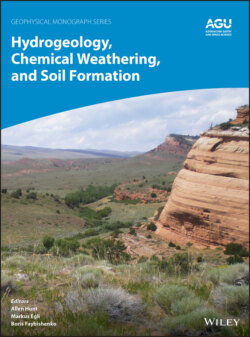Читать книгу Hydrogeology, Chemical Weathering, and Soil Formation - Allen Hunt - Страница 32
1.6. PROSPECT
ОглавлениеBig gains have come from viewing the soil as a system. From the early ideas on state factors, inputs and outputs, and transfers and transformation have evolved sophisticated models of soil landscapes and soils as a key component of the Earth system, and in particular of its critical zone. Of course, challenging questions in pedology remain, and it may take fresh approaches to answer them, but a systems approach still offers a powerful method of investigation. Indeed, Henry Lin (2011) demonstrates the value of such an approach in understanding spatial and temporal changes in soil systems and advancing forecasts and plans for changes related to critical societal needs. To do so, he brings together three general principles of soil change and pedogenesis in time and space (especially time):
First is the principle of conservation plus evolution, which provides the reconciliation of fast and slow changes in multiphase soil systems. Incomplete closure and partial irreversibility of many cyclic processes involved in soil functioning produce a range of residual solid products that accumulate over time, meaning that soil profiles record their own history, at least to an extent; this idea was first put forward by Aleksei A. Rode (1947) and later called “soil memory” (Targulian & Sokolova, 1996). Fast and slow changes in complex soil systems thus require an evolutionary and holistic approach to account for their connections and to quantify structural and informational accumulation alongside energy and matter conservation.
Second is the principle of dissipation plus organization, which explains the simultaneous processes of dissipation (that create the soil matrix) and organization (that create soil structure) that occur in the formation and evolution of natural soil systems. The idea is consistent with the theory of dissipative structure and self‐organization: soil entropy changes provide potential indices for the degree of soil weathering (residuals) and soil structural development (fluxes) once appropriate quantification is made. In addition to energy and mass changes, entropy change and its link to a complex system’s orderliness and information need to be quantified to gain a fuller understanding of soil complexity.
Third is the principle of space plus time, which highlights the fundamental differences and intimate links between time and space. Space is reversible (you can return to a location already visited), conservative in the sense that energy and matter cannot be created or destroyed but can be transformed and transferred, and structured in three dimensions; time is irreversible, evolutionary, and nonstructured (always moving in one direction); however, time and space both share the common characteristics of preferentiality (preference for different spatial locations and preference for different stable states through time) and thresholds (abrupt changes) that govern soil functions and soil evolution.
Lin admits that there are many unknowns in the workings of the soil system, but he argues that his three principles offer useful perspectives for modeling and predicting soil change and pedogenesis. They are certainly areas where the systems approach may provide new pedological insights that build upon the foundations laid by Dokuchaev, Jenny, Simonson, and the other giants of the discipline.
